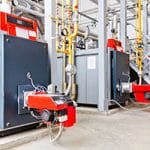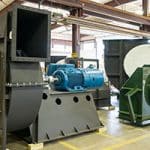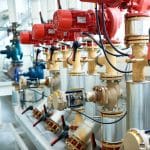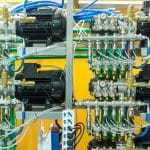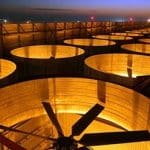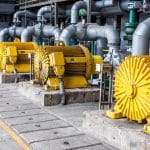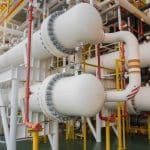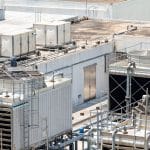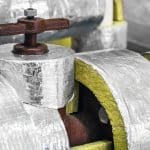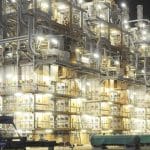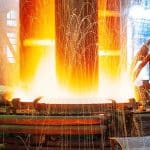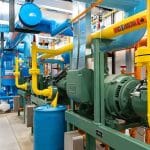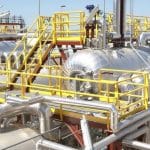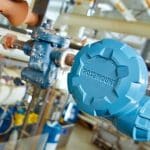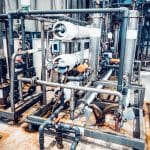The 3 kEys
- Develop a planned maintenance regime and stick with it. For every dollar of deferred maintenance, a facility is forced to spend four dollars at some point in time, to rectify what breaks as a result.
- Instrumentation and control systems play a vital role in heat exchanger maintenance. Temperature monitoring should track shell-side and tube-side outlet temperatures for each exchanger, as well as fluid temperatures at the entry point of the network.
- Consider advanced technological tools—such as Computational Fluid Dynamics (CFD) simulations—and their role in optimizing heat exchanger design and performance. Stay abreast with the newer technologies coming online, as many are not expensive, and provide ROIs that are significant, given the amount of energy a heat exchanger consumes.
A well-structured and proactive maintenance plan is essential for maximizing the efficiency and lifespan of industrial heat exchanger systems. We’ll highlight here the significance of routine inspections, ongoing maintenance strategies, and the role of regular upkeep in sustaining consistent performance.
The Importance of Regular Inspections
A strong maintenance approach begins with routine inspections. Scheduled visual assessments and testing are critical for detecting early signs of fouling, corrosion, or mechanical wear before they develop into costly failures. The frequency and method of inspections should align with the system’s operational demands and environmental conditions.
To prevent performance degradation, a systematic cleaning regimen is necessary. Over time, heat exchanger surfaces can accumulate fouling deposits, sediment, or contaminants, reducing thermal efficiency. Establishing a structured cleaning schedule helps mitigate these issues and ensures smooth operation.
Key components such as gaskets, seals, and tubes experience wear and tear. Regular maintenance checks help identify deteriorating parts, allowing for timely replacements that preserve system integrity. Additionally, undetected leaks—whether in tubes or joints—can lead to energy losses and operational inefficiencies. Routine leak detection and prompt repairs are essential for maintaining optimal performance.
For systems with automated controls, regular calibration of temperature sensors, controllers, and other instruments is vital. Proper calibration enhances precision in temperature regulation, contributing to overall system efficiency and reliability.
How Often Should You Maintain Your Heat Exchanger?
Not every heat exchanger needs the same level of attention. For systems in harsh environments or critical operations, frequent maintenance—even daily or weekly—can help catch issues early. In more stable environments, a less frequent schedule may suffice without sacrificing reliability. Knowing your system’s unique demands is key to creating a tailored maintenance plan. For additional insights into the importance of regular cleaning and maintenance, CSI provides us with a nice guide, found here: Cleaning and Maintaining Your Heat Exchanger: Complete Guide
Daily Insights: Keeping Heat Exchangers in Check
Visual inspections. Check for any visible signs of leaks around gaskets, seals, joints, and tubing. Inspect for abnormal discoloration, scaling, or corrosion on external surfaces. Observe for unusual vibrations or noises that could indicate loose or damaged components.
Temperature and pressure monitoring. Record inlet and outlet temperatures to detect any deviations from normal operating parameters. Monitor pressure drop across the exchanger; a sudden increase may indicate fouling or blockage. Ensure temperature sensors and pressure gauges are functioning correctly.
Fluid flow verification. Check flow rates on both hot and cold sides to ensure they meet design specifications. Confirm there are no flow restrictions or pressure fluctuations that could impact heat transfer efficiency. Inspect for signs of air pockets or vapor locking in the system.
Leak detection. Examine drain points, connections, and pipe joints for signs of leaks. Inspect for pooling liquids or dripping, which may indicate a failing gasket or tube breach. Use a leak detection system (if available) to verify system integrity.
Heat transfer efficiency check. Compare recorded heat transfer efficiency with historical data to detect any gradual decline. Watch for unexpected increases in energy consumption, which may indicate fouling or inefficiencies.
Cooling and condensation system checks. Ensure adequate cooling water or refrigerant flow is maintained. Look for signs of excessive condensation or inadequate heat dissipation.
Weekly Maintenance: Building on Routine
A weekly maintenance routine is essential to keeping the system running efficiently. Regular checks help detect wear, prevent buildup, and ensure peak performance before minor issues turn into costly failures.
In-depth visual inspection. Signs of corrosion, scaling, or fouling buildup on external surfaces can indicate potential performance issues. Gaskets, seals, and tubing should be carefully examined for cracks or deterioration, while all mounting hardware and brackets must remain secure and undamaged. If the heat exchanger has insulation, checking for signs of wear or breakdown can help prevent energy loss.
Performance monitoring and data logging. Monitoring performance is just as critical as visual checks. Weekly temperature and pressure readings should be compared against historical data to identify gradual changes that may indicate fouling or efficiency loss. Flow rates should also be reviewed to ensure they remain within expected parameters, and any unexpected increase in energy consumption could signal an underlying issue that needs attention.
Leak and integrity testing. Another important aspect of weekly maintenance is leak detection. A more detailed assessment of all connections, flanges, and joints can help uncover small leaks that might not be obvious during daily checks. If ultrasonic or infrared leak detection tools are available, they should be used to identify potential issues before they escalate. Additionally, drain points and drip trays should be inspected for any signs of accumulated fluids, as slow leaks can often go unnoticed until they become significant problems.
Cleaning and fouling prevention. Light surface cleaning can help remove dust and debris that may accumulate over time, and early signs of fouling—such as changes in pressure drop—should prompt immediate scheduling of a deeper cleaning. In some cases, a simple backflush or rinse can prevent buildup before it becomes a serious obstruction.
Component inspection. Thorough check of individual components is essential to maintaining system integrity. Gaskets, seals, and tubes should be examined for wear, and any deteriorating parts should be replaced to avoid leaks or inefficiencies. The heat exchanger frame and connections should be inspected for mechanical stress, ensuring that everything remains properly aligned. Cooling water and refrigerant supplies must also be assessed to confirm that they are free of obstructions or contamination.
Instrumentation & control calibration check. The calibration of instrumentation and control systems plays a vital role in overall performance. Verifying the accuracy of temperature and pressure sensors ensures that they are providing reliable data, while control valves and actuators should be tested to confirm proper operation. Any automatic safety and shutdown features must also be checked to ensure they are functioning correctly in case of an emergency.
Cooling & condensation system checks. Water quality should be checked for sediment buildup or signs of scaling, and cooling systems—whether water or air-cooled—must be free of blockages that could reduce efficiency. Condensate drain lines should also be inspected to confirm that they remain unobstructed and in good working order.
Monthly Deep Dives
A well-structured monthly maintenance routine is crucial for ensuring the long-term efficiency and reliability of an industrial heat exchanger. While daily and weekly checks focus on immediate performance and minor wear, a monthly assessment provides a deeper evaluation of system integrity, identifying gradual performance declines and addressing potential issues before they result in costly repairs or downtime.
Component assessment. A comprehensive inspection should begin with a thorough assessment of all components. The heat exchanger’s external surfaces should be checked for any signs of corrosion, scaling, or persistent fouling that may have developed over the past month. Gaskets, seals, and tubing should be examined closely for signs of deterioration, ensuring that no minor cracks or wear have progressed to the point of failure. Mechanical connections, mounting brackets, and support structures should also be inspected for any loosening or misalignment that could lead to operational inefficiencies or mechanical stress.
Performance monitoring. Undergo a detailed review of system data to track long-term trends. Comparing current temperature, pressure, and efficiency readings to historical performance records can highlight gradual declines in heat transfer efficiency. A steady increase in pressure drop may indicate progressive fouling, while unexpected fluctuations in temperature differential could point to underlying flow or mechanical issues. If discrepancies arise, scheduling a more intensive cleaning or component inspection can help restore optimal operation.
Deep cleaning. Incorporate into monthly maintenance to address any fouling or deposit buildup that has accumulated beyond what daily or weekly routines can manage. Depending on the type of heat exchanger and the nature of the process fluids, cleaning methods such as chemical flushing, high-pressure water jetting, or mechanical brushing may be required. Cleaning should extend to both primary and secondary heat transfer surfaces, ensuring that all potential obstructions are removed. If scaling or biofilm formation is detected, adjustments to water treatment programs or filtration systems may be necessary to prevent future recurrence.
Leak detection. Expand during monthly maintenance. While daily and weekly inspections focus on surface-level leaks, a more in-depth examination using advanced detection methods—such as dye penetrant testing, ultrasonic leak detection, or pressure decay tests—can help uncover slow or hidden leaks that could compromise efficiency over time. Special attention should be given to tube bundles, welds, and connection points where leaks are more likely to develop due to stress and thermal cycling.
Instrumentation and control system calibration. Perform to maintain operational accuracy. Temperature and pressure sensors should be verified against certified calibration standards, ensuring that readings remain precise. Control valves, actuators, and automation systems should be tested for responsiveness and reliability, and any deviations should be corrected to prevent inefficiencies in system regulation. Additionally, safety and shutdown mechanisms should be inspected and tested to ensure that they function correctly in the event of an emergency.
Cooling and auxiliary system review. Cooling water quality should be analyzed for chemical imbalances, sediment accumulation, or microbial growth that could lead to fouling or corrosion. If a closed-loop system is in use, verifying coolant integrity and replenishing inhibitors or antifreeze agents as necessary can prevent unexpected breakdowns. In systems using air-cooled heat exchangers, fans and finned surfaces should be cleaned to remove any dust or debris that might reduce airflow and heat dissipation.
Documentation and record-keeping. This is particularly valuable at the monthly level, providing a broad view of maintenance history and potential trends in system performance. Detailed reports of inspections, cleaning procedures, repairs, and efficiency assessments should be logged and reviewed to identify patterns that could inform predictive maintenance strategies. By analyzing these records, maintenance teams can optimize servicing schedules, reducing the risk of unexpected failures and improving overall heat exchanger reliability.
Quarterly Checkpoints
Heat transfer efficiency testing. Quarterly analysis provides a broader perspective on system performance. Key indicators such as heat transfer coefficient, approach temperature, and energy consumption should be compared against baseline values to detect any long-term efficiency losses. If efficiency declines significantly, this could signal deeper fouling, scaling, or internal degradation that requires corrective action.
Deep cleaning and descaling procedures. Often necessary on a quarterly basis – particularly in systems prone to scaling or process-related fouling – quarterly maintenance should incorporate chemical cleaning, hydroblasting, or mechanical brushing as needed. If significant fouling is found, evaluating and optimizing filtration, chemical treatment, or operational parameters may be necessary to prevent recurring deposits.
Leak detection and pressure testing. Go beyond simple visual inspections. A hydrostatic pressure test or pneumatic test can help identify minor leaks that may not yet be visible but could worsen over time. Dye penetrant or ultrasonic testing should be used for detecting hairline cracks in high-stress areas. Additionally, all connection points should be checked for proper torque to prevent future leaks due to thermal cycling or vibration.
Instrumentation recalibration and control system optimization. While weekly and monthly checks verify sensor function, quarterly maintenance should involve full recalibration of temperature sensors, pressure gauges, flow meters, and control systems to ensure precise and accurate performance. Automated controls and safety mechanisms should be tested under simulated load conditions to verify responsiveness and reliability.
Cooling system evaluation. Cooling water quality should be analyzed for pH balance, dissolved solids, and microbial contamination to prevent scaling, corrosion, and biofouling. If air-cooled systems are in use, fins and fan assemblies should be inspected for debris buildup or mechanical wear. Any signs of heat exchanger overheating or inadequate heat dissipation should be investigated to prevent long-term damage.
Comprehensive record-keeping and trend analysis. Data collected over the past three months should be reviewed to identify gradual efficiency declines or recurring maintenance issues. This information helps refine future maintenance schedules and allows for predictive maintenance strategies to be developed. If consistent trends point to performance degradation, adjustments in operational practices, cleaning intervals, or equipment upgrades may be necessary to maintain long-term efficiency.
Annual Overhauls
The process begins with a complete disassembly and inspection of critical components.
Detailed evaluation. Unlike routine visual checks, this detailed examination allows for the internal and external surfaces, gaskets, seals, tubes, and heat transfer plates to be closely evaluated for wear, corrosion, or stress damage. In shell-and-tube exchangers, tubes should be eddy current tested to detect thinning or hidden cracks that might not be visible during regular inspections. For plate heat exchangers, plates should be checked for warping, erosion, or gasket failure, and replacement should be considered for any components that no longer meet performance standards.
Cleaning and fouling removal. Throughout the year, scaling, fouling, and sediment buildup can gradually accumulate, reducing heat exchanger efficiency. While regular cleaning helps control surface-level deposits, the annual shutdown provides an opportunity for deep chemical cleaning, hydroblasting, or ultrasonic descaling to fully restore heat transfer surfaces. Cleaning methods should be selected based on the type of fouling present—chemical treatments for scaling, mechanical brushing for heavy deposits, or high-pressure flushing for removing sludge and debris. If fouling is found to be excessive, operational or water treatment strategies may need to be adjusted to prevent future recurrence.
Comprehensive performance testing. Unlike quarterly trend analysis, this involves a complete benchmarking of the system’s efficiency, heat transfer capacity, and energy consumption against its original design parameters. If efficiency losses exceed acceptable limits, engineering adjustments may be necessary, such as reconfiguring flow rates, upgrading heat transfer surfaces, or modifying operating conditions.
Advanced diagnostic pressure testing and leak detection. Hydrostatic pressure tests and helium leak detection should be conducted to identify any weakened areas that could lead to future failures. Weld joints, tube bundles, and gasketed surfaces should be carefully examined for structural integrity, and any necessary repairs or part replacements should be completed before reassembly.
Instrumentation and control systems. Engage in a full recalibration and verification to ensure precise operation. All temperature sensors, pressure transmitters, flow meters, and control valves should be tested and recalibrated to certified standards. Automated control systems and safety shutdown mechanisms should be tested under various simulated conditions to confirm proper response times and functionality. Any outdated or underperforming control elements should be upgraded to improve efficiency and system reliability.
Complete cooling system evaluation. Water quality should be assessed in detail, with testing for corrosion inhibitors, microbiological activity, and scaling potential to ensure long-term heat exchanger health. If cooling tower water or closed-loop systems show signs of contamination, a treatment plan should be implemented. In air-cooled heat exchangers, fan assemblies should be fully inspected, bearings lubricated, and finned surfaces cleaned or repaired as needed.
Historical maintenance records and performance data from the past year. Essential for refining future maintenance schedules, begin by analyzing past trends in efficiency, energy consumption, and component wear can help predict future maintenance needs and optimize preventative measures. This review should inform decisions about equipment upgrades, process improvements, or modifications to cleaning and inspection intervals to enhance long-term performance.
Instrumentation and Control Systems
Instrumentation and control systems play a vital role in heat exchanger maintenance. Temperature monitoring should track shell-side and tube-side outlet temperatures for each exchanger, as well as fluid temperatures at the entry point of the network. Inlet temperatures should align with upstream exchanger outputs, and flow rates of crude feed must be measured and recorded for accurate process control.
Consistent maintenance not only minimizes unexpected downtime but also enhances energy efficiency and reduces long-term repair costs. Consider advanced technological tools—such as Computational Fluid Dynamics (CFD) simulations—and their role in optimizing heat exchanger design and performance.
Sensorex has a pretty thorough article posted on their website, including a bit of a dive into CFD. I’d recommend reading it: Mastering Heat Exchanger Optimization for Sustainable Industrial Processes.
You might also begin to think about preheating your combustion air, and Sigma Thermal is in that business, with a narrative on preheating here: Combustion Air Pre-Heat Systems: Providing Savings on Fuel
A structured maintenance regime isn’t just good practice; it’s essential for keeping industrial heat exchangers running efficiently and reliably. From routine inspections to advanced cleaning techniques, every step you take reduces downtime, lowers costs, and extends equipment life. Combine that with ongoing monitoring and a well-trained team, and you’ve got a recipe for operational success.




